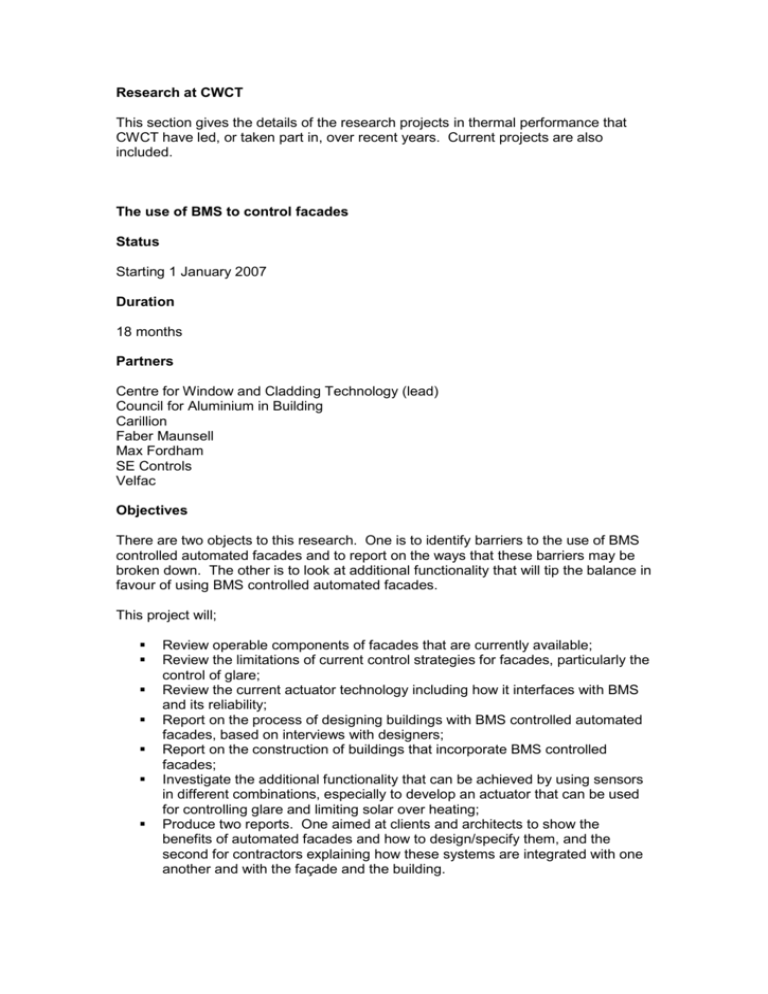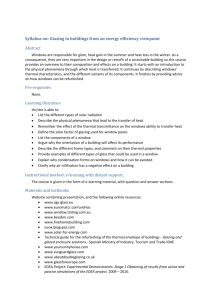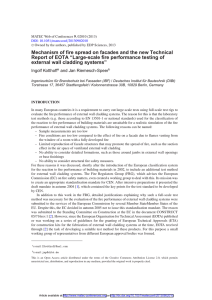Research at CWCT - Centre for Window and Cladding Technology
advertisement

Research at CWCT This section gives the details of the research projects in thermal performance that CWCT have led, or taken part in, over recent years. Current projects are also included. The use of BMS to control facades Status Starting 1 January 2007 Duration 18 months Partners Centre for Window and Cladding Technology (lead) Council for Aluminium in Building Carillion Faber Maunsell Max Fordham SE Controls Velfac Objectives There are two objects to this research. One is to identify barriers to the use of BMS controlled automated facades and to report on the ways that these barriers may be broken down. The other is to look at additional functionality that will tip the balance in favour of using BMS controlled automated facades. This project will; Review operable components of facades that are currently available; Review the limitations of current control strategies for facades, particularly the control of glare; Review the current actuator technology including how it interfaces with BMS and its reliability; Report on the process of designing buildings with BMS controlled automated facades, based on interviews with designers; Report on the construction of buildings that incorporate BMS controlled facades; Investigate the additional functionality that can be achieved by using sensors in different combinations, especially to develop an actuator that can be used for controlling glare and limiting solar over heating; Produce two reports. One aimed at clients and architects to show the benefits of automated facades and how to design/specify them, and the second for contractors explaining how these systems are integrated with one another and with the façade and the building. The use of double facades to facilitate on demand controlled ventilation Status: Starting 1 January 2007 Duration: 24 months Partners: Allies and Morrison Bennetts Associates Centre fro Window and Cladding Technology (lead) Council for Aluminium in Building Carillion Hoare Lea Sir Robert McAlpine Objectives: The objective of this work is to establish virtual precedents of the use of double facades that will provide a pressure moderated plenum from which air can be drawn for demand controlled ventilation. This project will; Undertake a desk study of wind events in the UK. This will include a review of the minimum conditions required to activate ventilation on demand; Postulate façade geometries for a number of building layouts to optimise the use of the thermal stack effect; Model the performance of a pressure moderated plenum of the double façade using CFD analysis. Different geometries will be looked at; Study existing building projects to determine the typical demands for ventilation and other factors controlled by the building envelope including daylight, solar gain, and heat transfer; Determine rules for use at the outline design stage using the information found above; Produce two reports. One will be written for use by clients and architects and will present information required to allow the inclusion of an effective double façade. The other will present an engineering methodology for use by the cladding and building services engineers. MODCELL: an innovative straw bale building system Status: Starting 1 January 2007 Duration: 24 months Partners: Agrifibre Technology Ltd Centre for Window and Cladding Technology Eurban Limited Integral Structural Design Lime Technology Ltd University of Bath (lead) White Design Objectives: This project aims to further develop an innovative sustainable building system using straw bale construction technology. Modcell building and cladding panels comprise a timber frame in-filled with straw bale insulation. The bales are compacted and reinforced with steel bars and protected with lime or cement based plaster coats. The project seeks to investigate and perfect the manufacturing methods and develop robust design data. The study will comprise laboratory and analytical research investigations, design studies, environmental performance modelling, life cycle assessment, and in-situ monitoring of prototypes. CWCT are involved in the thermal analysis and condensation risk assessment of the constructions. We will be carrying out; A literature review of material properties to obtain representative values for the thermal conductivity and vapour resistivity of straw bales; One-dimensional static thermal analysis and condensation risk assessment in order to investigate the effect of bale and render thickness; One-dimensional dynamic thermal analysis and condensation risk assessment in order to investigate the effect of bale and render thickness; Two- or three-dimensional thermal/moisture transfer analysis at the junctions between the Modcell panels and windows and doors; Three-dimensional thermal/moisture transfer analysis at localised thermal bridges. Hempcrete Status: Current Duration: Partners: BSA BRE Castle Cement CWCT Lhoist Lime Technology University of Bath University of Plymouth Objectives: Hemp construction is considered environmentally friendly and highly sustainable. The hemp can be mixing with lime to form ‘Hempcrete’ and can then be used as a building material in place of brick/blockwork. A project at Haverhill in Suffolk built two houses out of Hempcrete and these will be used as the basis of some of the following work. These houses were identical to some traditionally constructed houses so comparisons between the two could be made. CWCT will be studying the thermal performance of the Hempcrete construction. This will include; Reviewing the construction details and comparing them with those of a traditional building with the same geometry and usage; Assessment of all the building elements by either simulation or calculation; Dynamic heat transfer analysis to compare the temperature variation of hemp wall over the course of 24 hours with that of a brick-block wall with identical geometry; The effect of the surface finish. Different finishes will result in a different surface emissivity, and affect the therefore the U-value; Looking at, and comparing, the heat loss due to air leakage through both houses at Haverhill; Inputting data obtained previously into whole building energy consumption software to calculate the overall CO2 emission rate for the hemp house and the brick-block house at Haverhill. New façade technology – removing cold bridges Status: Complete (2003 – 2005) Partners: Centre for Window and Cladding Technology (lead) Permasteelisa Sandberg Objectives: The aim of this project is to study existing common construction details and products and to develop potential solutions to improve their thermal performance without affecting other aspects of performance. This will amount to a guidance of production trends in ten years time. The guidance will cover appropriate calculation methods for assessing the overall energy loss and condensation risk of different modern cladding systems and give potential best practice advice to remove cold bridging. The construction types to be considered will include: Curtain walling Rainscreen Punched windows Insulated panels The solutions to be considered will include; Thicker insulation materials; Alternative materials; Removal/reduction of metal components; Cladding and thermal shielding of components. Issues to be studied will include; Structural integrity; Thermal and acoustic performance; Durability; Buildability. Thermal performance of a window insert in stick system curtain walling Status: Complete (2004 – 2005) Partners: Centre for Window and Cladding Technology Council for Aluminium in Building Objectives: This project aimed to specify the methods for calculating U-values of different types of cladding system. Both simplified and detailed methods are specified. The project also calculated default values for the linear thermal transmittance of stick system curtain walls. These values were found by investigating the most commonly used systems in the UK and included the -value; At a glass edge; At a panel edge; Where you have an opening light at one side of mullion/transom; Where you have opening lights either side of mullion/transom. Full details are given in the CWCT guide ‘The thermal assessment of window assemblies, curtain walling and non-traditional building envelopes’ described earlier (LINK TO PAGE). Detailing modern non-domestic building envelopes to comply with the new Approved Document Part L of the Building Regulations Status: Complete (2002 – 2004) Partners: Centre for Window and Cladding Technology (lead) Permasteelisa Sandberg Objectives: The aim of this project is to develop and publish advice on detailing non-domestic building envelopes to comply with the new Approved Document Part L of the Building Regulations. This will amount to a 'robust detailing' guide that could in future be annexed to Part L. The guidance will cover appropriate calculation methods for assessing the overall energy loss and condensation risk of different modern cladding systems and give best practice advice to avoid cold bridging. The project will consider junctions and interfaces, fixings and penetrations associated with; Stick system curtain walling; Insulated panel walls; Unitised walls; Slope glazing; Rainscreen overcladding; Integral rainscreen. Assessing the heat loss at the insulating glass sealed unit edge Status: Complete (2001 – 2003) Partners: Azon Bostik Findley British Plastics Federation Windows Group British Woodworking Federation Centre for Window and Cladding Technology Chemetall Council for Aluminium in Building Glass and Glazing Federation (lead) Interpane National Physical Laboratory Pilkington Steel Window Association Tremco Objectives: In recent years glazing technology has made significant progress in improving energy efficiency, by the introduction of low-E coating of the glass and the filling of the space between the glass with heavy inert gas. These technologies are approaching maturity, and are well documented and understood. Warm edge technology, a range of techniques for replacing the aluminium spacer frame with less conductive metals, metal composites or other materials, is a more recent development, which has not been thoroughly researched, or authoritatively appraised. Current warm edge data resembles inspired market promotion, rather than factual comparisons of performance, when combined with other technologies, as required for future fenestration. The combination of technologies should enable the construction industry to identify routes to better windows, and therefore a significant contribution to energy conservation. The information developed by this project will enable all sections of industry to make informed selection of advanced performance fenestration. In order to meet the national targets for CO2 reduction, it will be necessary to make energy savings in both new construction and existing property stock. The adoption of high performance glazing will contribute to proposed and future targets for pollution control. This project involves both physical testing and calculation. NPL will test the thermal conductivities of the various systems available and carry out a series of hot-box tests, and make comparison between the test data and numerical modelling. CWCT will carry out thermal analyses of various combinations of materials and technologies. These include; Six types of window frame; Six types of glazing spacer; Three different glazing units.








